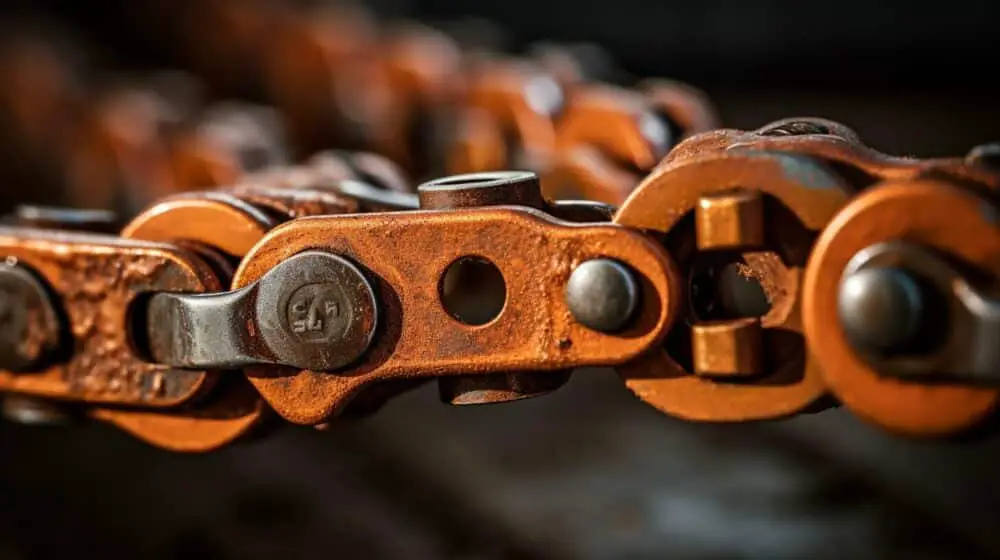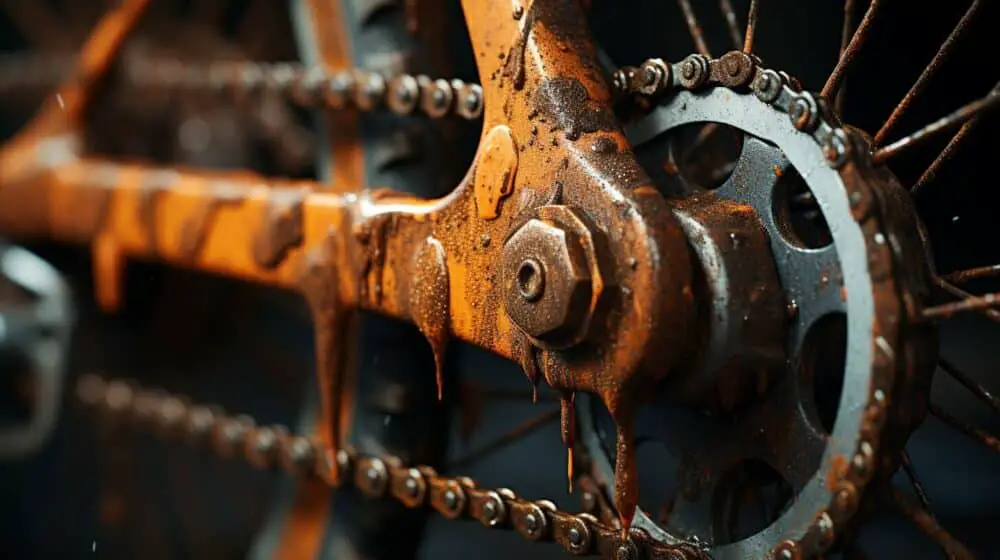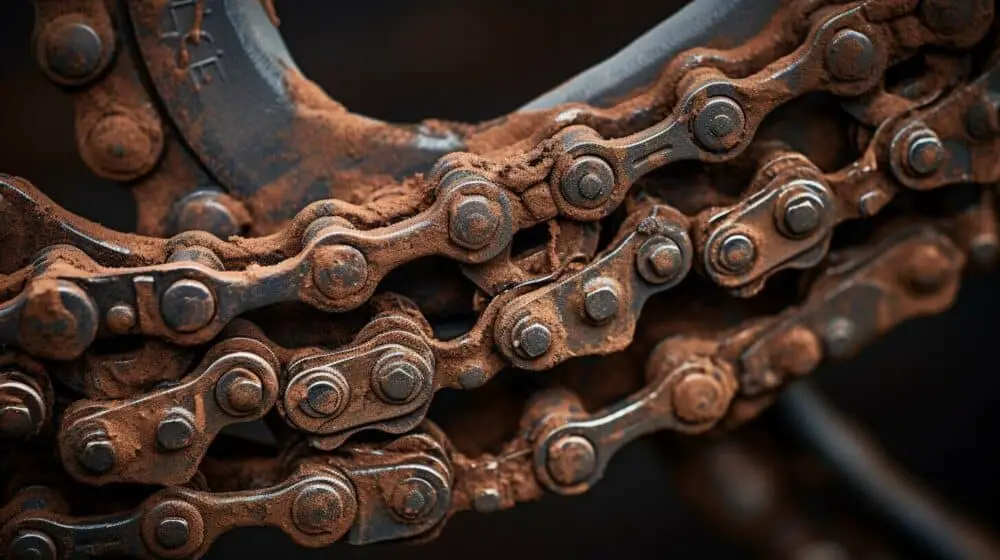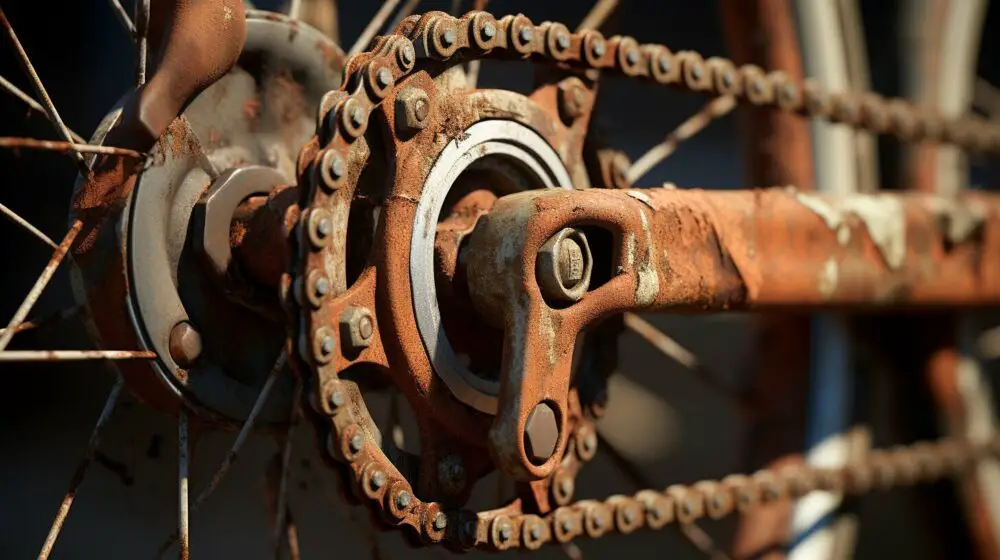Is your bike chain rusty and causing your rides to be less enjoyable? Don’t worry! In this step-by-step guide, we will show you exactly how to fix a rusty bicycle chain and get it back in perfect working condition.
Before we get started, it’s important to evaluate the condition of your bicycle chain. Determine how much rust has accumulated and if it can be salvaged or needs to be replaced. This will help you make the right decision on how to proceed.
If your chain has light rust build-up, we have a simple and eco-friendly solution for you. Using lime juice and steel wool, you can effectively remove the light rust and restore your chain’s functionality.
For chains with heavy rust, it’s necessary to remove the chain and use a degreaser to break down the rust. We’ll guide you through the process of soaking the chain and scrubbing away the rust to bring it back to life.
Some rust spots may be more stubborn and require additional measures. We’ll show you how to use WD-40 and a wire brush to tackle tough rust and ensure a thorough cleaning of your chain.
Once the rust has been removed, it’s time to reattach the cleaned chain and lubricate it for smooth operation. Proper reattachment and lubrication are key to ensuring a smooth and enjoyable bike ride.
If your chain is beyond repair, we’ll also discuss replacement options, including installing a new chain and understanding the role of the master link and other drivetrain components.
By following this guide, you’ll be able to fix a rusty bicycle chain and get back on the road with a smoother ride. Remember to regularly maintain your chain to prevent future rust build-up and keep your bike in top shape. Happy cycling!
Key Takeaways:
- Assess the condition of your bicycle chain before attempting to fix it.
- For light rust, use a mixture of lime juice and steel wool to remove the rust.
- Heavy rust may require removing the chain, soaking it in degreaser, and scrubbing away the rust.
- Stubborn rust spots can be tackled with WD-40 and a wire brush.
- Properly reattach the cleaned chain and lubricate it for smooth operation.
- If the chain is irreparable, explore replacement options such as installing a new chain.
- Regular maintenance is key to preventing future rust build-up on your bicycle chain.
Evaluating the Condition of Your Bicycle Chain
Before attempting to fix a rusty bicycle chain, it’s essential to evaluate the condition of the chain. Surface rust is a common issue that can occur when the chain is exposed to moisture or not properly maintained. By assessing the amount of rust and determining if it is superficial or deeply ingrained, you can make an informed decision on the best course of action to take.
If the chain only has small patches of surface rust, it may be salvageable with some cleaning and lubrication. In this case, you can proceed with removing the rust and restoring the chain to its optimal condition. However, if the rust has spread across the entire length of the chain and shows signs of corrosion, it may be irreversible and require replacement.
One way to evaluate the extent of the rust is to use a wire brush or steel wool to gently scrub the chain. If the rust easily comes off and the chain looks relatively clean underneath, it is likely that the rust is superficial and can be removed. However, if the rust is stubborn and does not come off easily, it may be a sign of deeper corrosion.
Evaluating the Condition of Your Bicycle Chain: Key Points
- Surface rust on a bike chain is a common issue caused by exposure to moisture or lack of maintenance.
- Determine the extent of the rust to decide if the chain can be salvaged or needs replacement.
- If the rust is superficial, proceed with removing it. If it is deeply ingrained or covers the entire chain, consider replacement.
- Scrub the chain with a wire brush or steel wool to assess rust severity. Superficial rust should come off easily, while deeper corrosion may be more stubborn.
Remember, proper maintenance is key to preventing rust on your bike chain. Regularly clean and lubricate your chain to keep it running smoothly and extend its lifespan.
| Rust Condition | Action |
|---|---|
| Surface rust | Remove rust using lime juice or a mild degreaser. |
| Deeply ingrained rust | Remove chain and soak in degreaser, scrubbing away rust with a wire brush. |
| Severe corrosion | Consider replacing the chain. |
 Removing Light Rust from the Bicycle Chain
Removing Light Rust from the Bicycle Chain
For chains with light rust build-up, there is a simple and eco-friendly solution using lime juice. Lime juice contains citric acid, which helps break down the rust and restore the chain’s functionality. Here’s how you can effectively remove light rust from your bicycle chain:
- Prepare a mixture of lime juice and water in a 1:1 ratio.
- Dip a piece of steel wool or an old toothbrush into the lime juice solution.
- Gently scrub the rusted areas of the chain with the soaked steel wool or toothbrush. Apply light pressure and work in circular motions.
- After scrubbing, rinse the chain thoroughly with clean water to remove any leftover lime juice.
- Dry the chain completely before reattaching it to your bike.
“Using lime juice to remove light rust is a cost-effective and environmentally friendly method. It’s also safe for most bike components, making it an ideal solution for minor rust issues.”
By following these steps, you can effectively remove light rust from your bicycle chain and improve its performance. Remember to regularly inspect and clean your chain to prevent rust build-up and ensure a smooth and enjoyable ride.
Removing Light Rust from the Bicycle Chain
When it comes to fixing a rusty bicycle chain, dealing with light rust can be relatively straightforward. One effective method for removing light rust from your chain is by using a natural and eco-friendly solution: lime juice.
To get started, dampen a piece of steel wool with lime juice. Gently scrub the affected areas of the chain, applying a bit of pressure to break up the rust. The acidity of the lime juice helps to dissolve the rust and restore the chain’s surface.
After scrubbing, rinse the chain thoroughly with soapy water to remove any remaining lime juice. This step will ensure that no residue is left behind, which could potentially cause further damage to your chain or bike components.

Remember, removing light rust from your bicycle chain is just the first step towards restoring it to optimal condition. If your chain has heavy surface rust or other stubborn rust spots, different methods may be required.
Removing Light Rust with Lime Juice
| Materials Needed: | Instructions |
|---|---|
| Steel wool | 1. Dampen steel wool with lime juice. |
| Lime juice | 2. Gently scrub rusty areas of the chain. |
| Soapy water | 3. Rinse the chain thoroughly. |
“Using lime juice to remove light rust from your bicycle chain is not only effective but also environmentally friendly. Give it a try and enjoy a smooth and rust-free riding experience!”
Removing Heavy Rust with Degreaser
If your bicycle chain is heavily rusted along its entire length, it’s necessary to remove the chain and use a degreaser to break down the rust. Follow these steps to effectively remove heavy rust and restore your bicycle chain:
- Start by turning your bike upside down or securing it in a bike rack for easy access.
- Evaluate the condition of the chain to determine if it needs to be replaced or can be salvaged. If salvageable, locate the master link and take a picture of the drivetrain for reassembly reference.
- If the chain has heavy surface rust, run it through a rag soaked in degreaser. Ensure all sides of the chain are covered with the degreaser, paying extra attention to the rusted areas.
- For chains with heavy grime or stubborn rust, it’s best to soak the chain in a degreaser for about 20 minutes. This will help break down the rust and make it easier to remove.
- After soaking, use a stiff-bristled brush or a toothbrush to scrub away the remaining rust and grime. Work the brush along the entire length of the chain, focusing on the heavily rusted areas.
- Once the chain is clean, rinse it thoroughly with water to remove any remaining degreaser or residue.
By following these steps, you can effectively remove heavy rust from your bicycle chain and prepare it for reattachment. Remember to use a lubricant to ensure smooth operation and avoid future rust build-up. Regular maintenance of your chain will prolong its lifespan and enhance your biking experience.

| Materials Needed: | Degreaser, rags, stiff-bristled brush or toothbrush, water |
|---|---|
| Steps: | 6 |
| Time Required: | Approximately 20 minutes for soaking |
| Skill Level: | Intermediate |
Breaking Up Tough Rust with WD-40 and a Wire Brush
To effectively tackle tough rust spots on your bicycle chain, you’ll need a combination of WD-40 and a wire brush. This powerful duo will help break up stubborn rust and restore your chain to its former glory.
Start by applying a liberal amount of WD-40 onto the rusty areas of your chain. WD-40 is a versatile lubricant that not only helps to loosen rust but also provides protection against future corrosion. Allow the WD-40 to penetrate the rust for a few minutes.
Next, take your wire brush and gently scrub the rusted areas of the chain. The wire bristles will help to dislodge and remove the stubborn rust particles. Be sure to scrub the entire length of the chain, paying extra attention to the areas with the most rust buildup.
After scrubbing, wipe away any excess WD-40 and rust debris with a clean rag. You should start to see the rust coming off, revealing a cleaner and smoother chain surface. If necessary, repeat the process until all the tough rust is gone.

Section 6: Reattaching the Cleaned Chain and Lubricating for Smooth Operation
Now that you have successfully removed the rust from your bicycle chain, it’s time to reattach it and ensure proper lubrication for a smooth ride. Follow these steps to complete the process:
- Inspect the Chain: Before reattaching the chain, take a moment to inspect it. Check for any damaged or bent links that may affect its functionality. If you notice any issues, it may be necessary to replace the chain.
- Reattach the Chain: Align the chain with the front chainring and the rear cassette or freewheel. Thread the chain through the derailleur and make sure it sits properly on the gears. Use the master link or a chain tool to secure the ends of the chain together.
- Lubricate the Chain: Applying the right lubricant to your chain is crucial for smooth operation. Choose a bike-specific lubricant and carefully apply it to the chain, focusing on each link. Make sure to cover the entire length of the chain but avoid excessive lubrication, as it can attract dirt and debris.
- Remove Excess Lubricant: After applying the lubricant, use a rag or cloth to wipe off any excess oil. This will prevent a buildup of dirt and help keep your chain clean and efficient.
You’ve successfully reattached and lubricated your cleaned chain! Remember to perform regular maintenance on your bicycle chain to prevent future rust build-up and ensure optimal performance. Now, hop on your bike and enjoy a smooth and enjoyable ride!
Troubleshooting Tip:
If you encounter any issues during the reattachment process or notice unusual chain behavior, consult a professional bike mechanic for assistance. They will be able to diagnose and resolve any potential problems.

| Step | Action |
|---|---|
| 1 | Inspect the chain for damage or bent links. |
| 2 | Align and thread the chain through the drivetrain components. |
| 3 | Secure the chain using the master link or a chain tool. |
| 4 | Apply lubricant to each link of the chain. |
| 5 | Wipe off excess lubricant with a clean cloth or rag. |
Replacement Options for Irreparable Chains
When it comes to rusty bicycle chains, sometimes the damage is irreparable, and a replacement is necessary. Understanding your replacement options is crucial to getting your bike back on the road. One option is to install a new chain, ensuring that it is compatible with your bike’s drivetrain components.
When selecting a new chain, consider factors such as the number of gears on your bike, the type of drivetrain (e.g., single-speed or multi-speed), and the width of the chain. It’s important to match these specifications to ensure optimal performance. Consult your bike’s manual or a professional mechanic for guidance if you’re unsure.
Another important component to consider is the master link. The master link is a removable link that allows for easy installation and removal of the chain. It is vital to correctly install the master link to ensure the chain’s proper functioning. Refer to the manufacturer’s instructions or seek assistance from a knowledgeable bike shop if you’re unsure how to install the master link.
| New Chain Replacement Options | Drivetrain Components |
|---|---|
| Consult bike manual or professional mechanic | Match specifications for optimal performance |
| Consider number of gears and width of chain | Ensure compatibility with drivetrain type |
| Install master link correctly | Seek assistance if unsure |
Replacing a rusty and irreparable chain not only improves your bike’s performance but also enhances your overall riding experience. By selecting the right chain and properly installing the master link, you can ensure a smooth and reliable ride. Remember to regularly maintain your new chain to prevent rust build-up and extend its lifespan. Happy riding!

Conclusion
Fixing a rusty bicycle chain is a simple process that can greatly improve your riding experience. By following the step-by-step guide outlined in this article, you can bring your chain back to life and enjoy a smoother, more enjoyable bike ride.
It’s important to evaluate the condition of your chain before attempting any repairs. Determine the extent of the rust and assess if the chain can be salvaged or needs to be replaced. If the chain can be salvaged, take a picture of the drivetrain for reassembly and locate the master link.
For chains with light rust build-up, you can use a natural solution using lime juice. Soak a piece of steel wool in lime juice and gently scrub away the rust. Rinse the chain with soapy water to remove any remaining residue.
If your chain has heavy surface rust or grime, it may be necessary to remove the chain and soak it in a degreaser. After soaking for 20 minutes, scrub away the rust with a wire brush. Finally, reattach the chain to the bike and apply a suitable bike lubricant for smooth operation.
Remember to regularly maintain your chain to prevent future rust build-up. By following these steps and incorporating proper maintenance into your routine, you can keep your bike’s chain in optimal condition and enjoy many more smooth rides ahead.
FAQ
Q: How do I know if my bicycle chain needs to be replaced?
A: You can evaluate the condition of your bicycle chain by checking for heavy surface rust, excessive wear, or damaged links. If the chain is severely rusted or compromised, it may need to be replaced.
Q: Can I salvage a rusty bicycle chain?
A: It depends on the extent of the rust. If the rust is light or moderate, you can clean and restore the chain. However, if the rust is heavy or the chain is severely damaged, it’s best to replace it.
Q: What should I do if my chain has light rust?
A: To remove light rust from your bicycle chain, you can use a solution of steel wool wetted with lime juice. Scrub the affected areas gently, then rinse with soapy water to remove any residue.
Q: How do I remove heavy rust from my bicycle chain?
A: If your chain has heavy rust, remove it from the bike and soak it in degreaser for 20 minutes. Use a rag soaked in degreaser to clean the chain thoroughly, ensuring all rust is removed. Rinse with soapy water and dry before reattaching.
Q: How can I break up tough rust spots on my chain?
A: WD-40 and a wire brush are effective in breaking up stubborn rust spots. Apply a small amount of WD-40 to the affected areas, then use a wire brush to scrub away the rust. Rinse with soapy water and dry before reattaching.
Q: How should I reattach the cleaned chain and lubricate it?
A: Once the rust has been removed, reattach the chain by following the manufacturer’s instructions or snapping a picture of the drivetrain for reference. Lubricate the chain with a suitable bike lubricant to ensure smooth operation.
Q: What are my options if my chain is irreparable?
A: If your chain is irreparable due to severe rust or damage, you can replace it with a new chain. Make sure to properly install the new chain and understand the role of the master link and other drivetrain components.




